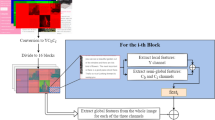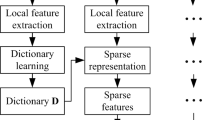Abstract
Screen content images (SCIs) are gaining widespread popularity due to the increase in computer processing power. Dissimilar to the natural images (NIs), SCIs are a mixture of texts, computer-generated graphics and natural images. Due to this reason, SCI and NI have different characteristics. Therefore, the quality assessment methods proposed for NIs are not suitable for assessing the quality of SCIs. In this paper, curvelet-based method (CurM-SCI) is proposed. Curvelet transform is used to extract edge features in CurM-SCI due to its superior directionality. CurM-SCI considers edge features from all orientations. However, most of the existing methods only deal with edge features from horizontal and vertical directions only. A new similarity equation which can handle negative values is also proposed to compare the coefficients of curvelet transform. Compared with the existing methods, CurM-SCI showed better performance.
Similar content being viewed by others
Availability of data and materials
All the data and figures utilized in this paper are publicly available from the published online databases as mentioned in the paper. The results in this manuscript have not been published elsewhere, nor are they under consideration by another journal.
References
Huang, C.Y., Chen, K.T., Chen, D.Y., Hsu, H.J., Hsu, C.H.: GamingAnywhere: the first open source cloud gaming system. ACM Trans. Multimed. Comput. Commun. Appl. 10(1s), 1–25 (2014). https://doi.org/10.1145/2537855
Lu, Y., Li, S., Shen, H.: Virtualized screen: a third element for cloud–mobile convergence. IEEE Multimed. 18(2), 4–11 (2011). https://doi.org/10.1109/MMUL.2011.33
Muelder, C., Zhu, B., Chen, W., Zhang, H., Ma, K.L.: Visual analysis of cloud computing performance using behavioral lines. IEEE Trans. Visual. Comput. Graph. 22(6), 1694–1704 (2016). https://doi.org/10.1109/TVCG.2016.2534558
Gu, K., Wang, S., Ζhai, G., Ma, S., Lin, W.: Screen image quality assessment incorporating structural degradation measurement. In: 2015 IEEE International Symposium on Circuits and Systems (ISCAS), pp. 125-128 (2015). https://doi.org/10.1109/ISCAS.2015.7168586
Wang, Z.: Applications of objective image quality assessment methods [applications corner]. IEEE Signal Process. Mag. 28(6), 137–142 (2011). https://doi.org/10.1109/MSP.2011.942295
Lin, T., Zhang, P., Wang, S., Zhou, K., Chen, X.: Mixed chroma sampling-rate high efficiency video coding for full-chroma screen content. IEEE Trans. Circuits Syst. Video Technol. 23(1), 173–185 (2013). https://doi.org/10.1109/TCSVT.2012.2223871
Ma, J., Plonka, G.: The curvelet transform. IEEE Signal Process. Mag. 27(2), 118–133 (2010). https://doi.org/10.1109/MSP.2009.935453
Gu, K., Qiao, J., Min, X., Yue, G., Lin, W., Thalmann, D.: Evaluating quality of screen content images via structural variation analysis. IEEE Trans. Visual. Comput. Graph. 24(10), 2689–2701 (2018). https://doi.org/10.1109/TVCG.2017.2771284
Gu, K., Wang, S., Yang, H., Lin, W., Zhai, G., Yang, X., Zhang, W.: Saliency-guided quality assessment of screen content images. IEEE Trans. Multimedia. 18(6), 1098–1110 (2016). https://doi.org/10.1109/TMM.2016.2547343
Fu, Y., Zeng, H., Ma, L., Ni, Z., Zhu, J., Ma, K.: Screen content image quality assessment using multi-scale difference of Gaussian. IEEE Trans. Circuits Syst. Video Technol. 28(9), 2428–2432 (2018). https://doi.org/10.1109/TCSVT.2018.2854176
Yang, Q., Ma, Z., Xu, Y., Yang, L., Zhang, W., Sun, J.: Modeling the screen content image quality via multiscale edge attention similarity. IEEE Trans. Broadcast. 66(2), 310–321 (2020). https://doi.org/10.1109/TBC.2019.2954063
Ni, Z., Ma, L., Zeng, H., Cai, C., Ma, K.: Gradient direction for screen content image quality assessment. IEEE Signal Process. Lett. 23(10), 1394–1398 (2016). https://doi.org/10.1109/LSP.2016.2599294
Ni, Z., Ma, L., Zeng, H., Chen, J., Cai, C., Ma, K.: ESIM: edge similarity for screen content image quality assessment. IEEE Trans. Image Process. 26(10), 4818–4831 (2017). https://doi.org/10.1109/TIP.2017.2718185
Ni, Z., Zeng, H., Ma, L., Hou, J., Chen, J., Ma, K.: A gabor feature-based quality assessment model for the screen content images. IEEE Trans. Image Process. 27(9), 4516–4528 (2018). https://doi.org/10.1109/TIP.2018.2839890
Huang Y., Wang, M.: An efficient quality assessment method for screen content image based on Gabor. In: 2020 IEEE 5th International Conference on Signal and Image Processing (ICSIP), pp. 201–205 (2020). https://doi.org/10.1109/ICSIP49896.2020.9339420
Donoho, D.L., Duncan, M.R.: Digital curvelet transform: strategy, implementation, and experiments. Wavelet Appl. VII (2000). https://doi.org/10.1117/12.381679
Liu, L., Dong, H., Huang, H., Bovik, A.C.: No-reference image quality assessment in curvelet domain. Signal Process. Image Commun. 29(4), 494–505 (2014). https://doi.org/10.1016/j.image.2014.02.004
Gao, X., Lu, W., Tao, D., Li, X.: Image quality assessment based on multiscale geometric analysis. IEEE Trans. Image Process. 18(7), 1409–1423 (2009). https://doi.org/10.1109/TIP.2009.2018014
Wang, Z., Bovik, A.C., Sheikh, H.R., Simoncelli, E.P.: Simoncelli: Image quality assessment: from error visibility to structural similarity. IEEE Trans. Image Process. 13(4), 600–612 (2004). https://doi.org/10.1109/TIP.2003.819861
Loh, W.T., Bong, D.B.L.: An error-based video quality assessment method with temporal information. Multimed. Tools. Appl. 77(23), 30791–30814 (2018). https://doi.org/10.1007/s11042-018-6107-1
Bong, D.B.L., Khoo, B.E.: Blind image blur assessment by using valid reblur range and histogram shape difference. Signal Process. Image Commun. 29(6), 699–710 (2014). https://doi.org/10.1016/j.image.2014.03.003
Bong, D.B.L., Khoo, B.E.: Objective blur assessment based on contraction errors of local contrast maps. Multimed. Tools. Appl. 74(17), 7355–7378 (2014). https://doi.org/10.1007/s11042-014-1983-5
Zhou, W., Yu, L., Zhou, Y., Qiu, W., Xiang, J., Zhai, Z.: Blind screen content image quality measurement based on sparse feature learning. Signal Image Video Process. 13(3), 525–530 (2019). https://doi.org/10.1007/s11760-018-1378-6
Shen, L., Zhang, C., Hou, C.: Saliency-based feature fusion convolutional network for blind image quality assessment. Signal Image Video Process. 16(2), 419–427 (2022). https://doi.org/10.1007/s11760-021-01958-7
Jiang, X., Shen, L., Yu, L., Jiang, M., Feng, G.: No-reference screen content image quality assessment based on multi-region features. Neurocomputing 386, 30–41 (2020). https://doi.org/10.1016/j.neucom.2019.12.027
Jiang, X., Shen, L., Ding, Q., Zheng, L., An, P.: Screen content image quality assessment based on convolutional neural networks. J. Vis. Commun. Image Represent. 67, 1–9 (2020). https://doi.org/10.1016/j.jvcir.2019.102745
Bianco, S., Celona, L., Napoletano, P., Schettini, R.: On the use of deep learning for blind image quality assessment. Signal Image Video Process. 12(2), 355–362 (2018). https://doi.org/10.1007/s11760-017-1166-8
Loh, W.T., Bong, D.B.L.: A generalized quality assessment method for natural and screen content images. IET Image Process. 15(1), 166–179 (2020). https://doi.org/10.1049/ipr2.12016
Fernandes, F.C.A., Van Spaendonck, R. L., Burrus, C. S.: A directional, shift insensitive, low-redundancy, wavelet transform. In: Proceedings 2001 International Conference on Image Processing, pp. 618–621 (2001). https://doi.org/10.1109/ICIP.2001.959121
Liu, A., Lin, W., Narwaria, M.: Image quality assessment based on gradient similarity. IEEE Trans. Image Process. 21(4), 1500–1512 (2012). https://doi.org/10.1109/TIP.2011.2175935
Candès, E.J.: Harmonic analysis of neural networks. Appl. Comput. Harmon. Anal. 6(2), 197–218 (1999). https://doi.org/10.1006/acha.1998.0248
Candès, E.J., Donoho, D.L.: Ridgelets: a key to higher-dimensional intermittency? Philos. Trans. R Soc. A Math. Phys. Eng. Sci. 357(1760), 2495–2509 (1999). https://doi.org/10.1098/rsta.1999.0444
Candès, E.J., Donoho, D.L.: Curvelets: a surprisingly effective nonadaptive representation for objects with edges. Technical Report No. 1999-28 (1999). https://purl.stanford.edu/hw450gp6206. Accessed 08 Dec 2022
Candes, E., Demanet, L., Donoho, D., Ying, L.: Fast discrete curvelet transforms. Multiscale Model. Simul. 5(3), 861–899 (2006). https://doi.org/10.1137/05064182X
Yang, H., Wu, S., Deng, C., Lin, W.: Scale and orientation invariant text segmentation for born-digital compound images. IEEE Trans. Cybern. 45(3), 519–533 (2015). https://doi.org/10.1109/TCYB.2014.2330657
Hansen, B.C., Essock, E.A.: A horizontal bias in human visual processing of orientation and its correspondence to the structural components of natural scenes. J. Vis. 4(12), 5–5 (2004). https://doi.org/10.1167/4.12.5
Hall, C.F., Hall, E.L.: A nonlinear model for the spatial characteristics of the human visual system. IEEE Trans. Syst. Man Cybern. Syst. 7(3), 161–170 (1977). https://doi.org/10.1109/TSMC.1977.4309680
Yang, H., Fang, Y., Lin, W.: Perceptual quality assessment of screen content images. IEEE Trans. Image Process. 24(11), 4408–4421 (2015). https://doi.org/10.1109/TCSVT.2019.2951747
VQEG: Final Report from the Video Quality Experts Group on the Validation of Objective Models of Video Quality Assessment, Phase II. http://www.its.bldrdoc.gov/vqeg/projects/frtvphase-ii/frtv-phase-ii.aspx. Accessed Sept 2003
Wang, Z., Simoncelli, E.P., Bovik, A. C.: Multiscale structural similarity for image quality assessment. In: 37th Asilomar Conference on Signals, Systems & Computers, pp. 1398–1402 (2003). https://doi.org/10.1109/ACSSC.2003.1292216
Wang, Z., Li, Q.: Information content weighting for perceptual image quality assessment. IEEE Trans. Image Process. 20(5), 1185–1198 (2011). https://doi.org/10.1109/TIP.2010.2092435
Zhang, L., Zhang, L., Mou, X., Zhang, D.: FSIM: a feature similarity index for image quality assessment. IEEE Trans. Image Process. 20(8), 2378–2386 (2011). https://doi.org/10.1109/TIP.2011.2109730
Xue, W., Zhang, L., Mou, X., Bovik, A.C.: Gradient magnitude similarity deviation: a highly efficient perceptual image quality index. IEEE Trans. Image Process. 23(2), 684–695 (2014). https://doi.org/10.1109/TIP.2013.2293423
Sheikh, H.R., Bovik, A.C.: Image information and visual quality. IEEE Trans. on Image Process. (2004). https://doi.org/10.1109/TIP.2005.859378
Acknowledgements
The authors would like to acknowledge funding and support from Ministry of Higher Education Malaysia and Universiti Malaysia Sarawak, through the provision of Fundamental Research Grant Scheme: FRGS/1/2020/TK0/UNIMAS/02/14 (UNIMAS reference number: F02/FRGS/2024/2020).
Funding
This work is supported by Ministry of Higher Education Malaysia and Universiti Malaysia Sarawak through the provision of Fundamental Research Grant Scheme: FRGS/1/2020/TK0/UNIMAS/02/14 (UNIMAS reference number: F02/FRGS/2024/2020).
Author information
Authors and Affiliations
Contributions
All authors contributed to the study conception and design. Data collection and analysis were performed by W-TL. All authors read and approved the manuscript.
Corresponding author
Ethics declarations
Conflict of interest
The authors have no conflict of interest that are directly or indirectly related to the work submitted for publication.
Consent for publication
All policies of the journal Signal, Image and Video Processing are agreed, and the authors agree to submit to this journal for publication.
Ethical approval and consent to participate
The principles of ethical and professional conduct have been followed. This research does not involve human participants and animals.
Additional information
Publisher's Note
Springer Nature remains neutral with regard to jurisdictional claims in published maps and institutional affiliations.
Rights and permissions
Springer Nature or its licensor (e.g. a society or other partner) holds exclusive rights to this article under a publishing agreement with the author(s) or other rightsholder(s); author self-archiving of the accepted manuscript version of this article is solely governed by the terms of such publishing agreement and applicable law.
About this article
Cite this article
Loh, WT., Bong, D.B.L. Screen content image quality assessment using curvelet transform. SIViP 17, 2025–2033 (2023). https://doi.org/10.1007/s11760-022-02415-9
Received:
Revised:
Accepted:
Published:
Issue Date:
DOI: https://doi.org/10.1007/s11760-022-02415-9




